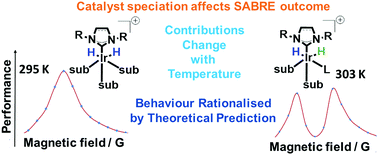A role for low concentration reaction intermediates in the signal amplification by reversible exchange process revealed by theory and experiment†
Abstract
A route to monitor the involvement of less abundant species during the catalytic transfer of hyperpolarisation from parahydrogen into a substrate is detailed. It involves probing how the degree of hyperpolarisation transfer catalysis is affected by the magnetic field experienced by the catalyst during this process as a function of temperature. The resulting data allow the ready differentiation of the roles played by hard to detect and highly reactive complexes, such as [Ir(H)2(NHC)(substrate)2(methanol)]Cl, from dominant species such as [Ir(H)2(NHC)(substrate)3]Cl. The difference in behaviour results from changes in the interligand spin–spin coupling network within the active SABRE catalysts.



 Please wait while we load your content...
Please wait while we load your content...